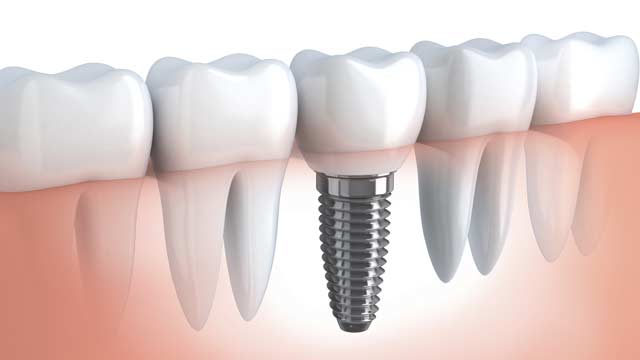Think of a false tooth like a drifting boat in the water.
If it’s going to stay in place it needs to be anchored down.
One option is to tie the drifting boat to two anchored boats on either side of it. This is what a traditional bridge does. It anchors the false tooth to the two teeth on either side.
The other option is to drop the drifting boat’s own anchor straight into the water. This is what an implant does. It anchors the false tooth to your actual bone, creating a new tooth root.
So how will this difference in anchoring affect your life? Let’s look at the 5 biggest impact differences…
#1: Tooth Damage
Bridge:
In order for a bridge to be placed, the enamel from your two anchor teeth needs to be removed. Crowns are usually placed on top of the anchor teeth to make up for damage done.
Implant:
An implant is anchored directly to the bone, so the teeth on either side are unaffected. It actually preserves their health by preventing them from shifting out of place.
#2: Functionality
Bridge:
Bridges can function fairly well to a point. Bridge wearers do have to avoid eating anything too hard or too sticky, as these can damage or break the bridge.
Food particles can easily accumulate between the bridge and gum, causing bad breath, gingivitis and eventually periodontal disease, so it’s very important to practice good maintenance. It’s good practice to use a toothbrush specially designed to reach hard to reach places and a proxy brush for open spaces.
Implants:
Since an implant is secured to the bone it acts as a real tooth, making no food off limits.
The implant shouldn’t need any special cleaning treatment beyond the normal routine. Of course, maintain regular brushing and flossing.
#3: Aesthetics
Bridge:
Bridges can look pretty good. The aesthetic issue that comes into play happens over time due to continued bone loss. The jawbone needs a tooth root to provide the pressure stimulus of chewing and when it’s missing, the bone resorbs into the body, changing the facial structure.
Implants:
Dental Implants are a replacement tooth root. The jawbone binds to the implant through a process called osseointegration and once they’re fused together, the bone receives the stimulation it needs. This keeps bone from being lost and keeps facial structure intact.
#4: Longevity
Bridge:
A bridge lasts on average 5-15 years and then it will need to be replaced. It will last longer the more carefully it’s maintained.
Implant:
An implant, unless something goes very wrong, is made to last a lifetime.
#5: Cost
Bridge:
The average cost to replace one tooth with a 3 unit bridge is $3,300.00.
Implant:
The average cost to replace one tooth with an implant is $4,263.
The Standard of Care
The standard of care for missing teeth has evolved. Bridges used to be the solution, whereas dental implants are now the clear choice.
Over the course of 30 years, you’ll likely need to get a bridge replaced 3 or more times, whereas a dental implant will remain with you throughout your life.
Money is saved in the long term and the benefits dental implants provide are life-changing.
It’s time to look at a cure instead of a band-aid. Submit a form or schedule a consultation with one of our providers to hear all about your new teeth options and get on the road to smiling again.
Article originally published at yournewteethnow.com.

